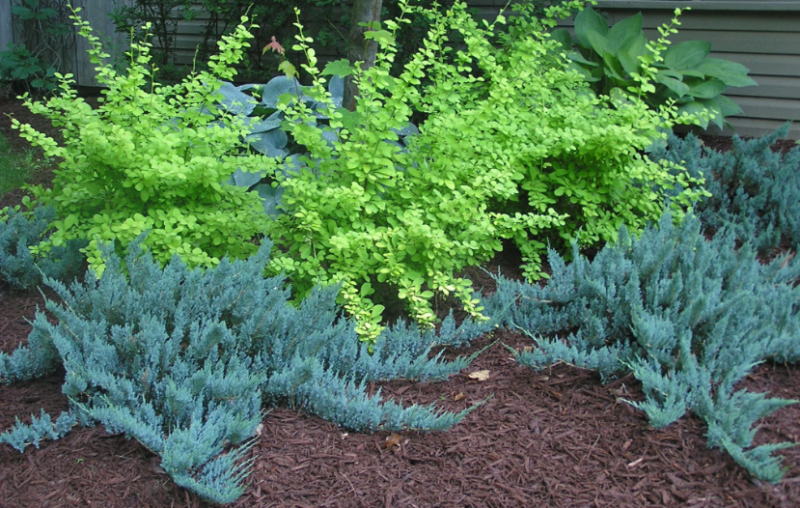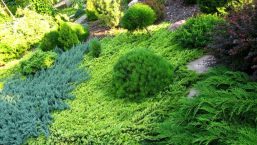One of the most popular ground cover plants used in landscape design is the Blue Chip Juniper. Its shaggy branches and decorative needles will not leave anyone indifferent.
Material Content:
Description of Juniper variety “Blue Chip”
In translation, the name of the plant Juniperus horisontalis Blue Chip means "blue chip". This evergreen shrub comes from North America. The height of an adult plant is only about 30 cm, but the crown can grow up to one and a half meters to the sides.
"Blue Chip" refers to ground cover shrubs. Often it is planted to support the slopes, to strengthen the curbs. This juniper is an ideal solution when choosing plants for rock gardens. Shrubbery looks great in containers. The plant is excellent in crown shaping. Juniper has a very beautiful needles of a bluish tint. Shrub growth is only about 10 cm per year.
How to plant and care for shrubs in open ground
Junipers are planted in April, as well as in autumn, while it is warm.
Juniper planting begins with the selection of a place for it. This plant loves light and well-moistened soil.
Planting a bush in a lowland with stagnation of moisture should not be. Does not tolerate the Blue Chip and excessive salinization of the soil.
Planting a plant step by step:
- The selected site is dug up.
- Mark holes with a depth of about 70 cm.
- At the bottom of the landing pit, drainage is made of stones or crumb brick.
- Between plants should be left about 2 meters.
- The seedling is removed from the container and together with a lump around the rhizome is placed in a hole.
- When planting, the neck of the plant should remain at the same level as it was in the container.
- Rhizome is covered with soil, rammed and watered.
- When the soil settles after watering, add soil and ram it.
- The seedling is mulched with chopped straw or peat, needles.
In the first few weeks after planting, while the plant is taking root, it must often be watered or sprayed with soil. After watering on moistened soil, weeds are removed and cultivation is carried out. Be sure to mulch the periostemal circles.
The plant is very responsive to the application of organic fertilizers. Junipers love vermicompost, although good results are given by top dressing with special mixtures for conifers.
- In the spring, in fertilizers, it is desirable that nitrogen prevail.
- In summer, shrubs need more phosphorus.
- In the fall, potassium is added under the junipers.
Fertilizers are introduced under the root in the periostemal circle.
In early spring, pruning is carried out. During the haircut, broken branches and dried ones are simply cut out.
Features of winter care
Creeping juniper is a frost-resistant plant and does not need any shelter for the winter. The only exceptions are young shrubs. They are covered with a spruce for the winter, and parabolic circles are mulched with fallen leaves or peat to protect the rhizome from freezing. Plants older than a year already tolerate winter well.
Juniper propagation
Juniper horizontal "Blue Chip" is well propagated by layering and cuttings.
The easiest method of reproduction is layering.
This requires:
- Choose strong branches and bend them to the ground.
- The soil must first be loosened and shed.
- After about 6 months, layering will take root.
- After this, the young plant can be separated and transplanted.
A more complex option is propagation by cuttings.
For this:
- Early in the spring, cuttings of 12 cm long are cut.
- The lower edge should be cleaned from bark and needles.
- Cuttings are buried in the soil of peat and sand, regularly watered, kept in a warm room.
- As soon as the stalk gives roots, it can be planted.
Protection against diseases and pests
Very often, when grown in open ground, parasitic insects attack the junipers: aphids, spider mites and scale insects. Early in the spring for preventive purposes, in order to protect shrubs from pests, they should be carefully treated with insecticides. Repeatedly spray junipers in mid-summer.
Of the diseases, this variety is susceptible to root rot and rust. If the juniper began to fade for no apparent reason, its shoots dry quickly, various spots began to appear on the needles, so it is necessary to spray the shrub with fungicides. A very effective remedy against diseases of conifers is Bordeaux fluid.
After treatment, it is necessary to fertilize the shrubs so that they regain strength after the disease.
In order to avoid the appearance of various diseases, juniper bushes should be treated with immunomodulating drugs in early spring. The Epin Extra, Novosil and Zircon remedies have proven themselves well for conifers. These drugs help strengthen the root system.
Landscape design
It is difficult to imagine a modern landscape design without various varieties of junipers. "Blue Chip" is the best suited for the preparation of plant compositions.
- Shrubs can be planted in a rocky garden or next to the lawn.
- A great decoration for a rock garden is the undersized “Blue Chip”, which, with the help of pruning, can be compacted.
- This variety is used to decorate artificial ponds.
- It is often the main part of mixborders made up of conifers.
- On a flower bed, juniper can play the role of a lush background for flowering annuals.
- Great neighborhood - large trees and other evergreen shrubs.
Junipers in the garden give it an elegant and noble appearance. In addition, these plants disinfect the air well and are very good for health.
"Blue Chip" is a very unpretentious variety, completely unpretentious to the conditions of cultivation and care. It can be grown in any region. Juniper looks the same beautiful in all seasons. High decorative characteristics of this variety were awarded with various awards at international exhibitions.

















